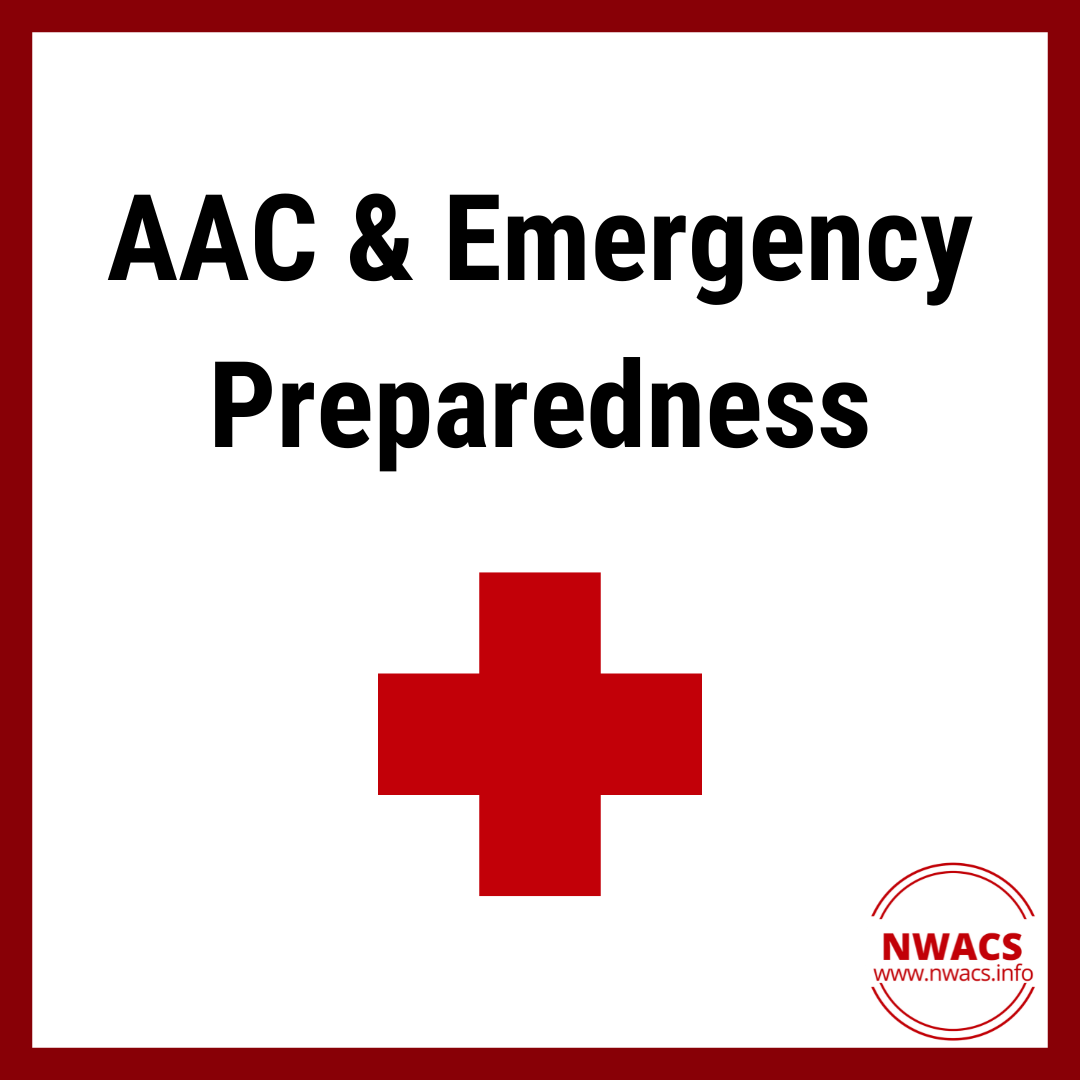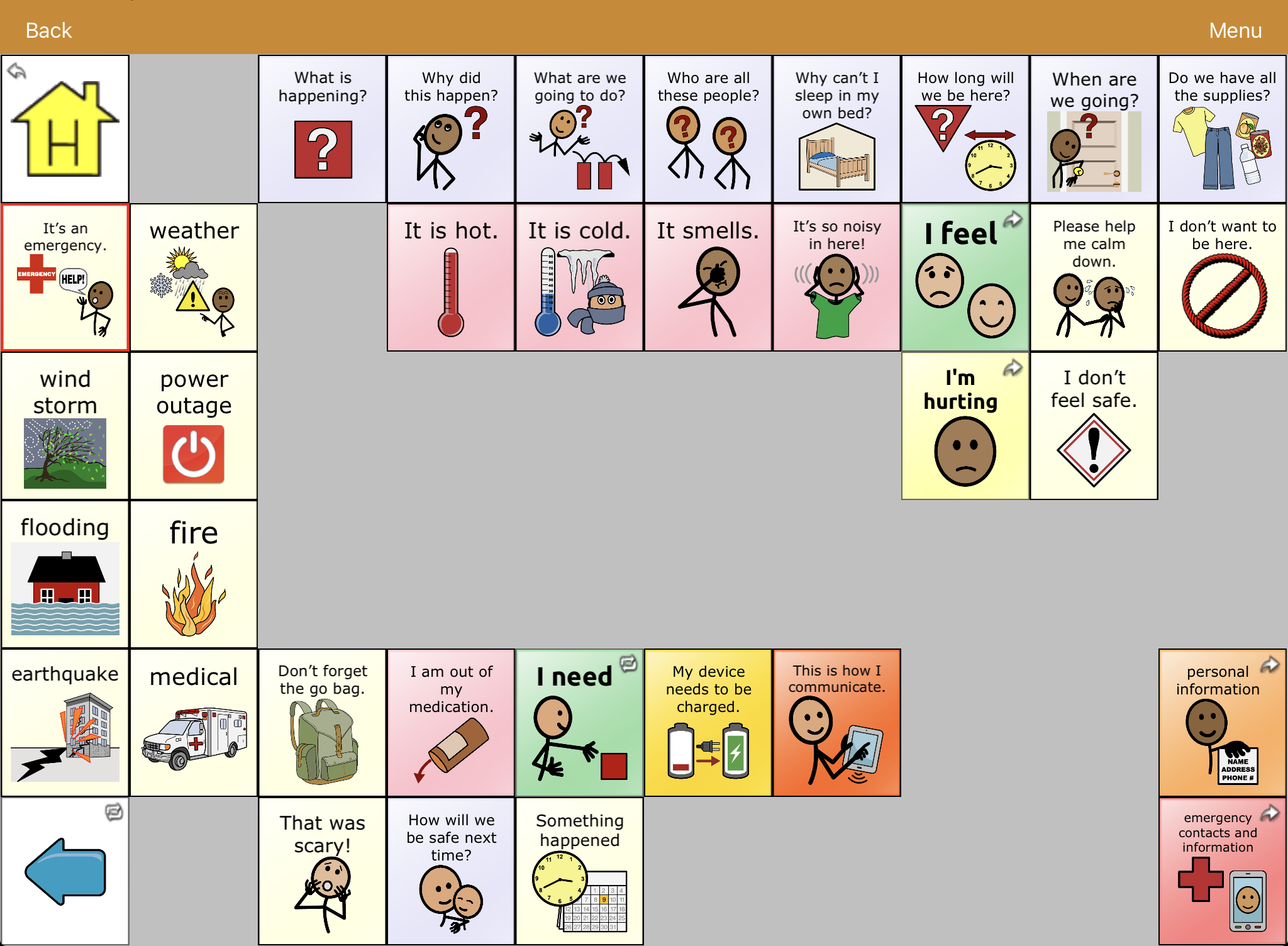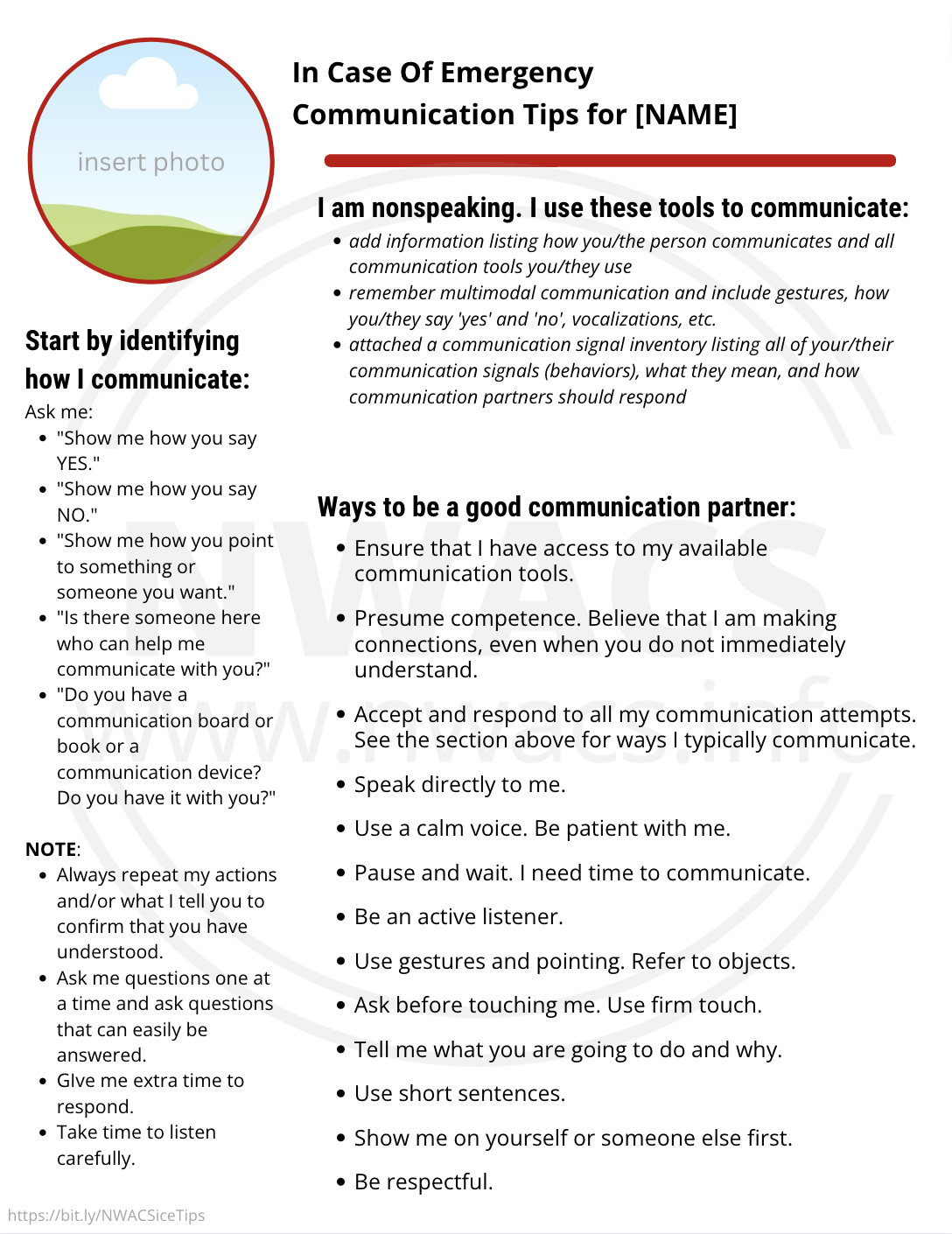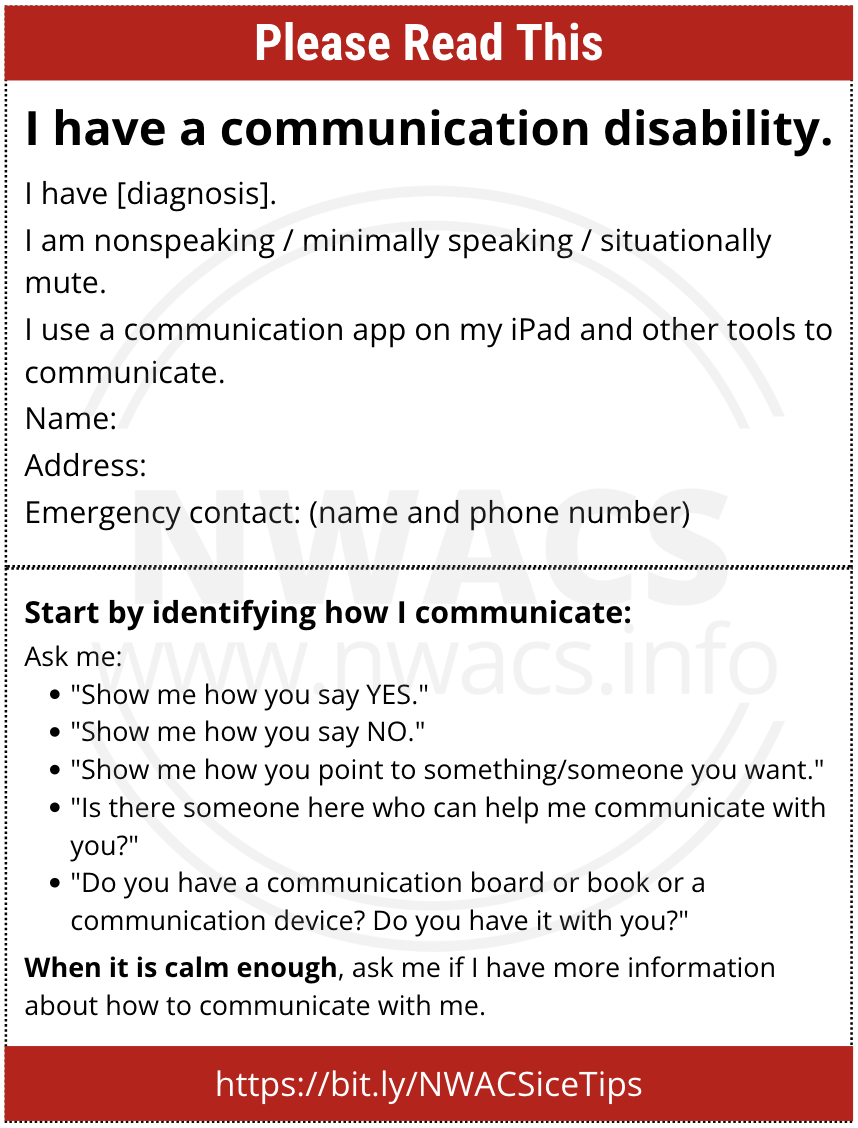AAC & Emergency Preparedness
This is a curated collection of information and resources related to emergency preparedness for complex communicators and AAC users. We encourage you to explore and judge for yourself which to add to your toolbox.
These resources are for educational purposes. This is not an exhaustive list. Inclusion does not signify endorsement. Use of any information provided on this website is at your own risk, for which NWACS shall not be held liable.
Do you have a favorite resource that we missed? Send us an email to share!
What is it and why do we need to worry about it?
Every region has a set of natural disasters common to that area. In the Pacific Northwest, we are at the mercy of:
Wind and rain storms.
Flooding.
Wildfires.
Landslides.
Power outages.
We also have earthquakes, volcanoes, and the risk of tsunamis. In other regions, weather events such as extreme temperatures, blizzards, hurricanes, or tornadoes may be possible every year. Terrorism, (traffic) accidents, and medical or health-related emergencies, including pandemics, can happen to any of us anywhere.
A natural disaster or other emergency can happen at any moment. How prepared are you? How prepared are the AAC users in your life?
Every disaster or emergency will have unique challenges. The more prepared we are, the better equipped we will be to handle them. The good news is that there are steps we can take to be ready when a disaster or emergency comes our way.
PLAN. PREPARE. PRACTICE.
The resources below will help you learn about all the different steps to take and items to collect to get ready in case of emergency or disaster. The Washington State Military Department’s Emergency Management Division recommends having supplies to last for as long as two weeks. Here are some highlights to get you thinking. Be sure to include your child/AAC user in this process. Part of knowing what to do in the event of an emergency or disaster is understanding the plan. Being part of the preparation can also help them manage their emotions. Doing this together gives everyone an opportunity to ask questions, suggest ideas, and include items/preferences that are important to them. Think now about how to make the experience as safe and comfortable for all.
PLAN
Start by developing a plan. Put the plan in writing. And share it with your family and team members.
Do you have a support team? Does everyone know what to do?
Make a list of contact information for all the people you might need to contact. Remember to include one person outside of the area where you live who (most likely) will not be impacted by your local disaster.
Build a support network. Think about who you can rely on. Discuss disaster plans with these people.
Do you have an evacuation plan? For home and school or work?
Be prepared to be flexible. You will need to go in the safest direction to the nearest safe place.
Be ready to go quickly. Your Go Bag and other needed items will need to be easy to grab and take with you.
Do you have a Go Bag and a Stay Box? For home and work?
Pack ahead!
Know the list of other frequently used items that you need to grab and take with you (e.g., keys, purse/wallet, phone and charger, medicine, laptop and charger, comfort items, etc.).
Plan ahead for specialty medical, feeding, care, and communication supplies.
Does your AAC user:
know what to do in an emergency? (who to trust, where to go, what to say to get help, etc.?)
have access to words and messages allowing them to communicate about the emergency?
know personal and emergency information? (own address, phone number(s) for contacts, etc.?)
For people with mobility issues and physical disabilities:
Plan ahead for transportation.
Make a plan for damaged ramps, rails, equipment.
Review and update your plan quarterly!
PREPARE
When emergencies/disasters happen, you will not have time to think and pack everything you need. Gather all of the items you need to have ready ahead of time. Pack items in your Go Bag and your Stay Box. Label all equipment (things get lost easily in shelters). Store your Go Bag and Stay Box in easy-to-access places.
How will you stay informed?
Red Cross app
FEMA app
Local emergency app (if available)
Portable/Battery-operated radio (and batteries)
How will you charge/power equipment and devices?
Generator?
Portable power banks?
Gather important documents in a binder or folder (stored in a waterproof container)
Print and laminate instructions on how to communicate with the AAC user; we have created this template to help you get started
Consider the need for any other instructions (e.g., feeding, lifting, special care needs, etc.)
Print and laminate back-up communication boards and other communication tools (e.g. visual schedule)
Have a back-up copy of your device
Don’t forget your communication equipment, including all needed accessories (e.g., batteries, charger, switches, mounts, software, etc.)
You will also need:
A map of your area with different evacuation routes marked
Cash (small bills); slowly start saving small bills to keep in your Go Bag
Flashlight and batteries
First aid supplies
Think about other needed supplies:
Feeding equipment? Other medical/needed equipment and supplies?
Clothes?
Toiletries/hygiene items?
Sanitizer/wipes?
Masks?
Sensory/comfort items?
Additional items for a Stay box:
Water (a gallon per person, per day, for at least 3 days)
Foods that won’t spoil and do not need to be cooked
Extra plastic bags with ties and a bucket (for a toilet)
Example emergency communication page designed in TouchChat HD AAC with WordPower
TIP: Consider connecting with local fire / police in advance to let them know someone has special considerations. Check to see if you can register with your local emergency services and/or your electricity company.
REMINDER: Don’t forget to program emergency/disaster-related messages, vocabulary, and information into the AAC user’s primary communication system. Then model and practice using those messages.
PRACTICE
Practice your plan to help everyone understand what to do. Practice is one step to helping everyone feel safe. Run through your plan to work out the kinks. Then practice regularly so that everyone remembers what to do and how to do it.
Additional Considerations:
Sometimes we have the benefit of a warning that an emergency or disaster is coming. But not always. There are no guarantees with the unexpected and/or unpredictable. So it is vitally important, especially for people with disabilities, to do all we can to Be Prepared and Be Ready!
We can be anywhere when an emergency or disaster happens. Home. School. Work. Shopping. Traveling. Out in the community. Do you and your AAC user always carry:
Identification
Photos of family members and pets can help you reunite if you get separated.
ICE (in case of emergency) card/information?
A copy of critical health information, prescriptions, and any other important documents (in a waterproof bag)?
For example, an emergency information form provides a medical summary describing medical condition(s), medications, and special health care needs to inform health care providers of a person’s health conditions and needs so that optimal emergency medical care can be provided.
A laminated light-tech communication display?
Communication is key to survival, safety, and well-being. Make sure there is always a back-up system immediately accessible.
It is easy to put this off. Or to think it will never happen “to me”. Reality check: emergencies and disasters can (and do!) happen to anyone.
Notes:
Emergencies happen at school and work too. Make sure there is a plan in place for those locations. Be sure to discuss your child’s school’s emergency procedures and the specific plan for your child.
On July 27, 2023, @powerfullyisa shared a powerful (and heartbreaking) post on Instagram. Isa wrote: “* I had consent to share these stories. I received many many more, but did not have space to include all. Thank you to all who sent in for sharing in hopes of raising awareness* I always knew that disabled people were often left out of emergency prep plans and were often left behind in real emergencies. Naïvely, I thought that If disabled people were able to set up plans with schools, they would be safe. But these stories showed that even when disabled people advocate for themselves, even when plans are made, disabled people lives are still not valued enough to save. Individualized emergency plans need to be part of the law, need to be the norm, and when they are in place they MUST be trained for, and followed. Many disabled people do not know this is an option or possible, administrators should work with families to inform them of there importance. So here is a reminder for students, parents, teachers, administrators to make a plan. Disabled lives are worth saving. (And a reminder that this happens and matters in non school settings too such as workplaces)” Click or scan the QR code to read through the slides in Isa’s post. CW: stories of students’ being left or put in dangerous situations at school.
Even with thorough planning, the AAC user might still lose some or all of their AAC tools and technology. If that happens, reach out to the USSAAC Disaster Relief project for help getting a replacement at no cost. For more information, head to the USSAAC website: https://ussaac.org/relief-recovery/
NOW IS THE TIME TO TAKE ACTION!
Explore the resources below to help you PLAN, PREPARE, and PRACTICE! We recommend starting with the USSAAC course Disaster Preparedness for People Who Use AAC. There are a lot of good suggestions and information in the other links below, so be sure to check them out too! Even a partial plan is better than no plan. Feeling overwhelmed? Get a friend to start preparing at the same time. Motivate, inspire, and problem-solve with each other.
We have created this checklist to help you keep track of where you are at in your preparations. You can do this!
Resources
Articles, Books, Documents
Are You Prepared? (2024) NWACS blog
Augmentative and Alternative Communication Disaster Preparedness: Roles, Responsibilities, and Opportunities for Speech-Language Pathologists and Other Professionals by Miriam C. Boesch , Elizabeth Begley , Sarah Blackstone and Tina Caswell
Do you have an IEP Emergency Plan? School Shootings | Weather | Evacuation blog post from A Day In Our Shoes (Lisa Lightner)
Emergency Communication - Are we prepared? blog post by Kathy Smith on the NWACS blog
Emergency Preparedness For Red Sky, or Lack Of. blog post by Four Wheeling Through Life (a power wheelchair and AAC user)
Ready Now! Emergency Preparedness Tool Kit from Oregon Health & Sciences University
Materials
Communication Tools and Material: Emergency & Disaster Preparedness for People Who Use AAC from Patient-Provider Communication
Create communication tools to meet the communication needs and situations in the AAC user’s life:
Light-tech options (laminated and/or printed on waterproof/tear-proof paper)
check out these resources for printable communication boards
Tools like the HandyTalker from CoatneyCreations on Etsy or PicSeePal
Partner-assisted scanning (auditory and/or visual), for example, based on a PODD book
Develop a multimodal system of communication and ensure all team members recognize/know the AAC users’ multimodal signals, including
vocalizations
gestures
light-tech communication boards, books, etc.
mid- and/or high-tech tools
Emergency Communication Aid from Texas DSHS (available in English, Spanish, and American Sign Language)
Emergency Communication Tips template (including wallet card) from NWACS
Emergency or Disaster Board from CoughDrop
Free Customizable Printable AAC Emergency Communication Board and Keyboard (by OMazing Kids AAC Consulting)
Free Downloadable Emergency Communication Aids from Temple University Institute on Disabilities
Plan. Prepare. Practice. Checklist (printable) from NWACS
Prepare in a Year guide from the WA Military EMD (available in English, Chinese, Korean, Russian, Spansih, and Vietnamese)
RescueVoice from The University of Iowa Research Foundation (available on iPad and Android devices)
Websites
AAC-RERC website (2008-2013)
ADA National Network
American Red Cross: Disaster Safety for People with Disabilities
Emergencies and Disasters: Readiness - resources from USSAAC
Also explore the USSAAC Emergencies and Disasters: Communication Tools page
Emergency Communication AAC Vocabulary information and resources from Temple University Institute on Disabilities
Oregon Health & Science University - University Center for Excellence in Developmental Disabilities
Seattle Emergency Management
University of Colorado Denver - Center for Inclusive Design and Engineering
Washington State Department of Health: Be Prepared, Be Safe
Washington State Development Disabilities Administration (DDA)
Washington State Military Department’s Emergency Management Division
Videos / Webinars
Be prepared! What you need to know for People Who Use AAC AAC in the Cloud presentation (recording) by Amy Goldman
Disaster preparedness for people with complex communication needs: A personal perspective webcast by Pamela Kennedy as part of the work of the AAC-RERC
Emergency Planning for AAC Users AAC in the Cloud presentation (recording) by Kathryn Helland
Emergency Preparedness for People with Disabilities webinar (recording) from OHSU
Emergency Preparedness for People with Disabilities: Heat Waves, Wildfire and Power Outages webinar (recording) from OHSU
PWUAAC in Emergencies and Disasters: Tales from the Trenches webinar (recording) from USSAAC
What, Why, and How of Disaster Preparedness: You and Your AAC Users UCF AAC Collaborative presentation (recording) by Amy Goldman
Selected References:
American Academy of Pediatrics, Committee on Pediatric Emergency Medicine and Council on Clinical Information Technology, American College of Emergency Physicians, Pediatric Emergency Medicine Committee; Emergency Information Forms and Emergency Preparedness for Children With Special Health Care Needs. Pediatrics April 2010; 125 (4): 829–837. 10.1542/peds.2010-0186
Barton-Hulsey, Andrea & Boesch, Miriam & Chung, Yoosun & Caswell, Tina & Sonntag, Amy & Quach, Wendy. (2023). Emergency and Disaster Preparedness for Individuals Who Use Augmentative and Alternative Communication: A Pilot Study on Supported Planning Using a Toolkit. American Journal of Speech-Language Pathology. 1-17. 10.1044/2023_AJSLP-23-00086
Boesch, Miriam & Begley, Elizabeth & Blackstone, Sarah & Caswell, Tina. (2022). Augmentative and Alternative Communication Disaster Preparedness: Roles, Responsibilities, and Opportunities for Speech-Language Pathologists and Other Professionals. Perspectives of the ASHA Special Interest Groups. 7. 1-7. 10.1044/2022_PERSP-21-00274
Fox, M. H., White, G. W., Rooney, C., & Rowland, J. L. (2007). Disaster Preparedness and Response for Persons With Mobility Impairments: Results From the University of Kansas Nobody Left Behind Study. Journal of Disability Policy Studies, 17(4), 196–205. https://doi.org/10.1177/10442073070170040201
Sally Lindsay & Shaelynn Hsu (2023) Emergency and disaster preparedness among children and youth with disabilities and chronic conditions, their caregivers and service providers: a scoping review, Disability and Rehabilitation, DOI: 10.1080/09638288.2023.2185294
Villeneuve, M. (2022, February 24). Disability-Inclusive Emergency Planning: Person-Centered Emergency Preparedness. Oxford Research Encyclopedia of Global Public Health. Retrieved 2 Sep. 2023, from https://oxfordre.com/publichealth/view/10.1093/acrefore/9780190632366.001.0001/acrefore-9780190632366-e-343.













